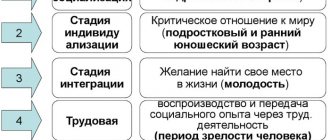One of the most interesting and mysterious areas of our psyche is the world of emotions. Studied for thousands of years by scientists from various fields of knowledge, it still keeps many of its secrets and mysteries. Emotions permeate our entire life, making it bright, rich, sometimes tremulous and tender, sometimes filled with unbearable burning pain. Yes, they are this life itself, because where feelings disappear, human existence ends.
It is psychology that most fully reveals the essence of this area of the human psyche - the only science that has managed to organically link together the physiological basis and manifestations of emotional states.
What are emotional states
In psychology, the concept of “emotions” is used both in a broad sense, as emotional states, and in a narrow sense, as one of the types of these states, along with feelings, moods, affects, etc. Emotional states are a special class of mental phenomena that reflect attitudes man to the world.
Emotions and needs
Interacting with the world around us and with other people, a person constantly encounters situations that evoke different attitudes in him: joy or indignation, sadness or hatred, surprise or sympathy. That is, a person reflects the world and stores information in memory not only in images and concepts, but also in the form of sensory experiences - emotions.
Emotions are closely related to human needs. Those life circumstances, situations or people that contribute to the satisfaction of needs cause us positive emotions, and those that interfere or hinder us cause negative emotions. It's so simple and complicated at the same time.
- Firstly, we are not always aware of our needs, but we always experience the emotions associated with them. Therefore, we often cannot even explain to ourselves why we don’t like this or that person, or why our mood suddenly deteriorated.
- Secondly, a person lives a complex and multifaceted life, and often his needs come into conflict not only with the needs of other people, but also with his own desires. Therefore, understanding this confusing and chaotic whirlpool of emotions can be extremely difficult even for an experienced psychologist. You probably know that you can love and hate the same person at the same time, or be afraid and look forward to some event at the same time.
You can deal with your experiences only by realizing and bringing your confused desires and needs into at least relative order. Experienced psychotherapists can help a person with this. After all, only by understanding and accepting your needs or consciously abandoning them can you reduce the severity of negative experiences.
Psychophysiology of emotional states
Emotions are the oldest type of mental states; animals have them and are associated with the satisfaction of natural, and in higher animals, social needs.
- The antiquity of this type of mental state is confirmed by the fact that they are born in the old, from an evolutionary point of view, subcortical part of the brain - in the limbic system. By the way, the name is very telling. Limbo is purgatory, a place between heaven and hell, and even deeper lurks animal instincts and hidden, often dark desires and needs. They sometimes break through from the subconscious level, awakening in us strange emotions that frighten even ourselves.
- But the expression of emotions is controlled and controlled by the “youngest” and most rational part of the brain – the neocortex (“new cortex”). And when the rational part of the brain turns off, for example, during severe alcohol intoxication or in a state of passion, then emotions go out of our control, and behavior begins to be controlled by instincts, not reason.
Any external influence causes a focus of excitation in the cerebral cortex. If the irritation is weak, then the focus quickly fades, but the stronger the impact, the larger and more stable this focus is. Penetrating into the subcortical zone, it activates the centers of emotions.
Emotions, in turn, cause various changes in the physiological systems of the body, because emotions are a signal about the nature of the impact of the stimulus. And if they are negative, then our body is rebuilt, preparing to repel danger or run away from it. Moreover, for our brain, it turns out, it doesn’t matter whether the enemy is real or imaginary - the signal to restructure the body’s functioning is still received, and we experience various, often unpleasant, sensations. Thus, the emergence of a feeling of fear is accompanied by the following processes:
- Adrenaline is released into the blood, which should increase the supply of oxygen to the muscles and activate the sympathetic nervous system;
- blood and nutritional resources are directed to support the muscular system; this reduces the supply to other body systems, so a person feels cold, chills, his face turns pale, and due to lack of blood supply, dizziness and even loss of consciousness may occur;
- in order to cope with the increased needs for blood supply, the heart begins to beat faster, breathing quickens to supply the blood with oxygen and, as a result, difficulties arise with speech;
- rational control over behavior decreases, since the functions of the cerebral cortex are somewhat suppressed, and the person literally becomes stupid and does not think rationally well.
Changes in the functioning of various body systems under the influence of emotions are reflexive in nature, so we cannot consciously control them, but we can control emotions, at least at the initial stage of their occurrence. Our brain is quite capable of “persuading” the body not to succumb to feelings of fear or anger. And in psychotherapy there are special techniques and trainings that allow a person to learn to manage their emotions even in the most critical situations.
Managing emotions is necessary not only to regulate behavior, but also to maintain physical health. The fact is that negative feelings (and they are experienced more strongly by a person than positive ones) have very unpleasant consequences. Their systematic experience can lead to the development of psychosomatic diseases, primarily of the cardiovascular and digestive systems. It is these systems that are most affected by adrenaline surges and other physiological changes. That is, the saying: “All diseases come from nerves” has a rational basis.
Feelings in childhood
Carefree time, in fact, filled with hard work to form a personality, its emotional immunity, stability, resilience in difficult life situations. During this period, the foundations of empathy are laid, the lack of which in adult life is very difficult to cultivate and compensate for.
Factors of a child’s sensory development:
- formation of higher nervous activity;
- attitude of parents and other adults;
- communication with peers;
- features of the educational process;
- gradual expansion of the range of situations that evoke a response.
It is very important to teach your child not only to express, but also to distinguish between the experiences of other people. Relationships with parents are of particular importance in this. Being loved and loving, living in safety and affection, children open up, gain confidence and peace of mind for life.
Face-to-face consultation
What are the features and advantages of face-to-face consultation?
Find out more
Skype consultation
What are the features and benefits of Skype consultations?
Find out more
Types of emotions
The most ancient and primitive type of emotional states are states of pleasure and displeasure, which are classified as the simplest organic sensitivity. These experiences are associated with the satisfaction (or dissatisfaction) of natural needs and are felt by a person even more physiologically than psychologically. For example, when, after a long and tiring day spent on your feet, you sit down in a soft, comfortable chair.
But most of our emotional states are “humanized,” that is, they are conscious in nature and associated with activity and social relationships.
Moods
This is the most generalized type of emotional states. Moods, on the one hand, are weakly expressed, and on the other hand, they create the background of all our activities, as if coloring our life at one stage or another.
The mood is quite stable. Changing it depends not only on the situation, but also on personal characteristics. In people with a mobile nervous system, moods are less stable and change frequently.
The most important characteristic of mood is its non-objective character. This emotional state creates a background, but is not associated with a specific subject. Although a person may well be aware of the circumstance that spoiled his mood, the emotion itself extends not only to this circumstance, but also affects activity (everything falls out of hand, you want to quit everything, etc.) and interpersonal relationships. Often we take our bad mood out on those who have nothing to do with it, or share our joyful well-being with the whole world.
Emotions
Actually, emotions (in the narrow sense) and feelings are quite close and similar, and psychologists are still arguing which of these emotional states can be attributed to a higher level and which is more primitive. But this is important for science, but does not play a role in everyday life.
Emotions themselves are more short-lived than moods, but also more clearly expressed. The power of expression of emotions is also much higher than that of mood. Emotions are more conscious of a person, and he clearly differentiates them: joy and anger, fear and hatred, pleasure and hostility.
But the main difference between emotions and moods is that they are objective and aimed at a specific object or situation. These emotional states are social in nature, that is, they are part of the communication process; a person conveys his emotions (with the help of facial expressions, pantomime, intonation, gestures) to other people and is able to perceive them, empathize, and sympathize with others.
Emotions have another unique feature - we are able to experience them in relation not only to a real situation, but also to an imaginary one. Memories and adventures of the heroes of books and films can also evoke emotions.
Feelings
This type of emotional state, just like emotions, is associated with certain objects. We love or hate very specific people, phenomena and situations. It is generally impossible to love, to experience feelings of respect or hostility. But feelings are longer lasting, more stable than emotions, deeper and more varied. And we can also say that feelings are more socialized and depend on a person’s interaction with the people around him. Therefore, feelings are varied, and there are several types of them:
- objective feelings are the largest variety of feelings associated with various aspects of human existence; these include, for example, admiration and disgust, feelings of the sublime and a sense of humor (comic);
- moral feelings are associated with relationships in society (love, hatred, sense of duty, friendship, envy, etc.);
- intellectual feelings are associated with cognitive needs (curiosity, inquisitiveness, a sense of mystery, doubt, confidence, etc.);
- aesthetic feelings arise in response to the perception of the beautiful or ugly in nature and art; in general, they can be characterized as the experience of pleasure or displeasure, pleasure or disgust, etc.
This classification, of course, is not entirely accurate and complete, since any feeling is essentially subjective. But it reflects quite well the diverse and colorful palette of human feelings.
Affect and stress
Affect is a very strong and vivid emotional response to a sudden situation that threatens a person’s health and life. The effects are short-lived, but they are expressed in a sharp activation of all the protective functions of the body. We can say that all the strength and hidden reserves of a person are directed towards getting rid of the cause of such strong negative emotions.
Cases are described when, in a state of passion, people jumped over four-meter fences and climbed tall trees. There was even a case recorded when a woman, saving a child from under the wheels of a car, was able to turn it over into a ditch by hitting the side of a small truck with her hands.
The peculiarity of affect is that it is accompanied not only by a powerful release of physical and emotional energy, but also by a state of altered consciousness. It manifests itself in a person’s loss of rational control over his actions. The subject seems to fall out of reality, and then cannot remember what he did in a state of passion. In criminology, murders committed in this state are classified as special types of crimes, since the person is not aware of his actions and does not control them.
After the affect comes a “rollback” - having used up all his strength, even internal reserves, a person feels weak, his hands tremble, his legs become “wobbly,” and sometimes he even loses consciousness.
Stress is similar to affective states in that it occurs as a response to a traumatic or threatening situation. But it is less strong and longer lasting. What is important is that stress is not accompanied by a change in consciousness and a shutdown of rational control. Although a person immersed in the cycle of his problems may not realize that he lives in a state of stress.
Stress also activates the body’s strengths, not only physical, but also intellectual. But in the initial stages this is felt as increased tone and a kind of stimulation of activity, and internal reserves are not spent. Only prolonged stress is harmful to a person, which leads to overload of the nervous system, chronic fatigue syndrome, and even depression.
Main characteristics
One of the ways of transmitting and perceiving information is emotional coloring. We have taught our smartphones to convey facial expressions by sending the desired emoticon in a written message. It helps to express what we have experienced or experienced.
- Surprise, which provokes curiosity, encourages exploration and learning new things.
- Dislike helps protect against harmful and dangerous things and preserves health. It is associated with the instinct of self-preservation.
- Positivity brings joy and goodness; at the level of consciousness, it improves memory and develops erudition.
- Fear and cowardice, which protect against danger, make the reaction lightning fast.
- Rage and irritation are our self-defense; they sweep away obstacles like a hurricane and lead to achieving our goals.
- Melancholy and despondency bring not only dullness and apathy. When we are sad, we become closer to other people, stop the rush of events and pay attention to those aspects of life that were previously left outside.
To put it briefly, how emotions differ from feelings is that they are not private. For example, a family quarrel, the wife accused her husband of not having time to pick up the child from school. They speak in a raised voice and sound irritated and annoyed. But even if they were both silent, their faces, bodies and eyes would give them away. Most of our reactions have signals that clearly and easily communicate to others what we are feeling. While our thoughts remain inaccessible.
Psychologist Daria Milai
Make an appointment
Functions of emotions
Emotional states bring us many moments of pleasure, but often seem unnecessary. We would like to get rid of negative experiences, not worry about loved ones, not experience feelings of anger or fear. But emotions, even the most unpleasant ones, perform very important functions in our lives.
- Controlling or regulating function. Emotions, like negative or positive experiences, control our behavior, form motives and are the strongest incentive. After all, any living creature strives for what brings pleasure and tries to avoid unpleasant sensations.
- Evaluation function. Emotions help us make sense of a complex world and bring order to our relationships. They evaluate everything that happens to us: both good and bad. This assessment allows us to divide people into friends and enemies, and events into pleasant and unpleasant.
- Protective and mobilizing function. Emotions warn us of danger, and they also turn on the defense mechanisms of our body and mobilize forces to solve the problem.
- Signal or expressive. Emotions play a huge role in communication, conveying information to other people about our state and attitude. Expressive movements that accompany emotions are an important part of nonverbal communication.
- Synthesizing function. Emotions are a kind of “cement mortar” that connects events, images, and phenomena in memory. It is emotions that create in memory single blocks-complexes of events connected by experiences.
But along with positive and undoubtedly important and necessary functions, emotional states can also play a disorganizing role, that is, interfere with a person’s normal actions. The feeling of fear can develop into panic, which prevents you from properly comprehending the situation and making the right decision. Anxiety prevents you from concentrating on activities, for example, solving a problem on a test. And love, too, sometimes makes one’s head so dizzy that a person can no longer think about anything and does not evaluate his actions sensibly.
However, there is a way out. A person may well learn to control emotions and subordinate them to the control of the mind.
Definition of feelings in psychology and examples
They are characterized by depth and stability. This is not an outbreak, but a process that manifests itself in attitudes towards people, values, and behavior. I distinguish between high and low sensory levels. The first is related to social life and is divided into:
- Moral. Formation of a value system that implies an attitude towards friendship, fidelity, love, decency, compassion. It is brought up over the years, developed under the influence of family and environment, personal life experience and principles.
- Intelligence. Manifests itself as a result of learning and cognitive activity.
- Perception of beauty. It is carried out through art, cinema and literature.
The need to understand a concept, to comprehend it, is how a person’s feelings differ from his emotions. They cannot be imagined without deep analysis and evaluation. For example, to love your Motherland, you need to know what this word means, who patriots are, what they experience and how they behave. It can be difficult for us to explain what we feel. A loving mother is boiling over the mess in the room, and a guy in love is angry when he reads a text message that the meeting will not take place.
How to understand them
To never make a mistake when classifying two concepts, imagine a control panel with many buttons. Each initiates a process that is predictable, inevitable, and reversible. The mechanism is simple: they turn on the stimulus and get an emotional reaction. Even a baby who has barely learned to hold his head can understand it. Mom smiles at him, which means he’s doing well, and a reciprocal smile will appear on his face; she knitted her eyebrows and raised her voice - he would cry, he was scared and offended.
Awareness of your mood is often quite simple. We are able to explain why we are worried. Feelings are more difficult to explain. They are like a background onto which emotionality is projected. He is able to combine love and anger, joy and pain, melancholy and tenderness.
At any moment we can stop and understand what we feel, where this experience comes from, and what it is connected with. To do this, it is important to correctly express thoughts in words, to be able to describe the process of brain activity and the causes of your condition as accurately as possible. If you don’t listen to yourself, you can get a bunch of mental disorders ranging from psychosis to severe depression.










